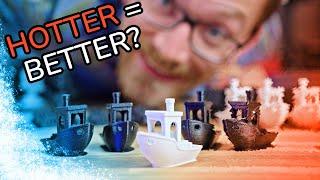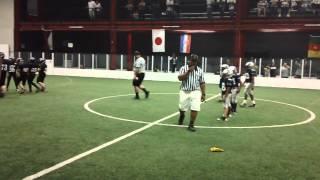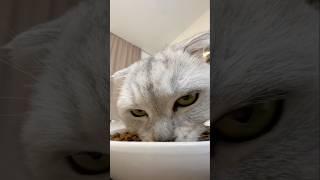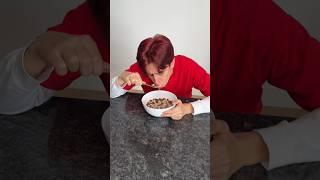
Are you printing at the right temperature?
Комментарии:

Die swell from extrusion pressure being higher at lower temps?
Ответить
Great video! Would be interesting to see (part of) the test repeated for fine tuning. So eg PLA at 209, 212, 215, 218, 221 or so.
Ответить
300th comment!
Great content. Appreciate the video and especially all the effort.

The day I learned that "Prusa degrees' are a thing ;D
Ответить
I had to lower temperatures when used 0.2 nozzle. When print in low height rows standard 230C degrees with PETG result in deformations and stringing, so I use 220C instead. Which gave me decent quality on small detail.
Ответить
Thanks!
Ответить
Thanks for the info...however in engineering terms, impact strength is different to tensile strength. Strength in printed parts with regards to heat and adhesion properties is always going to be governed by application needs. So, print variables should be practiced depending on application. No one setting is actually better than the next. That would be my conclusion. Thanks for the great and interesting content. Much appreciated.
Ответить
So if I print PLA at a higher temperature I can raise the print speed without too many downsides?
I'd love to increase my print speed anyway I can so long as it's not sacrificing too much detail.
Strength isn't really much a concern currently with what I want to print.

Is there a test for surfaces of supported prints. Mine are always rubbish whatever I try to do?
Ответить
I was thinking I was running super hot when I was printing at 210 c for pla but you're telling me 215 c?
Ответить
Constructive criticism.. reconsider your force to break test methodology. The pipe used as a lever has a variable angle of incidence on the printed test part, when it appears you are trying to test vertical strength.. you are actually testing strength in a constantly changing Y and X vector. Rig up a pulley that is in between the luggage scale and your force input and you will constrain it to the Y axis.
Ответить
Lower temp parts are overdimensioned because leaving the nozzle retaining the stress of a larger filament expand in XY and contracts in Z to retain its previous shape. Raising temps or using turbulent nozzles like CHT reduce the effect.
Ответить
Where do I find the tomtest?
Ответить
What about high temp for high speed?
Ответить
Could you do a speed and temperature test? Lots of work, but for instance I print petg at 150mm/s,0.4mm nozzle and 270c.
Ответить
And here i've been tearing my hair out trying to get good PLA prints at the Cura default of 195C. 215, here we come!
Ответить
I'm currently using the Bambu Lab 3d printer P1S. It's an enclosed printer. I noticed that the smaller surface area I'm working with, the hotter I need to print, but I'm only heating up the bed from 35C to 55C. The biggest issue I believe I was having, was the Bambu default settings for the cooling fans is maxed out. My parts were flying off the bed.
Definitely going to take some time to learn the best settings for heating and cooling.

spoiler: yes!
Ответить
does PETG Print better at higher temperatures with overhangs or worse, honestly against my understanding, I get higher print quality on overhangs with higher temperatures and I am not really sure why; perhaps the part fans are aggressive?
Ответить
Ok the hammer test was waaaaaaay to satisfying 🤣
Ответить
JJLC
Ответить
All those prints looked honestly horrible except the bend test ones .. slow your printer downn
Ответить
I did a nozzle change recently, and i realized 😂 I needed to print significantly hotter because the nozzle was “clogging” but really it just was t following good enough.
Ответить
So what it looks like is just go with the mid-range of the suggested print temperatures; got it
Ответить
I just keep upping the temp until the extruder stops skipping!
Ответить
I print pla at 220° 50%speed -2.20 z
Ответить
hi. Did yoy change the cooling settings? if not it is BSh. ;) 195 for pla I use 1% for 230 40%
Ответить
K1 max 15min benchy boat 600mm/sec hyper pla+ 240c is flawless. So device makes a huge difference. I fine enclosures make the biggest difference.
Ответить
my elagoo fillament pla in black says 205 - 230 but a tempreture tower produces best results at 190c i do first layer at 200 but that is quite different to manufactures recommendation. in short print a temp tower on every new fillament batch thats what i do anyway
Ответить
im a total noob, got me a p1s and after two weeks i started to play around with temps.... standard setting is 220 , i turned it down just a lil bit to 217 and its alot better now... can it be a few degree make such a big difference??
Ответить
Including your flow rate would have been very usefull. I don't know what flow rate the standard 0.6 nozzle prusa profile uses.
Ответить
You need to incorporate the health aspects of printing with the different temperatures.
Ответить
why is 0.6 the best size?? im kinda new
Ответить
So colder or hotter, got it! 😂
Ответить
dud e why are you not changing the first layer temp, thats like the most important setting
Ответить
Probably a video somewhere in your library, but my lizard brain needs to get this out while I'm thinking it... what are the effects of the colour dyes on temperature/quality? I would assume a black filament, for example, would absorb more thermal radiation than a transparent one.
Ответить
Been printing in pla + vertical but it been so week any tips on how to make it stronger
Ответить
Do you have plans for the impact tester setup you used? I like the simplicity of your tester. I'd like to build something similar to impact test with
Ответить
One important thing is the environment temperature. I print in 23°C environment without enclosure and my PLA Benchy is with PLA Polymaker at 205°C fantastic. My Voron with enclosure (doors are opend) I have around 30°C and my Benchy has overhangs. First I thought it's because the new mosquito hotend and wrong cooling geometry but I think it's because the environment temperature.
So if you print don't forget the environment temperature for PLA

thank you so much, i always have problems with dimensions of my parts and tried everything to fix it. I will now test higher temp bc i have always printed at 195°
Ответить
Watching this makes me glad I can create project profiles directly on my old faithful Ultimaker S3 dual nozzle printer (with NFC filament recognition) (auto levelling & heating). Using preset profiles that I found can include all known and customisable settings, making it easy for novices like me, to start at commercial grade printing qualities, without the hassle of knowing in advance what's required, just splice and load to get projects completed quickly, with a professional finish that requires little to no post processing.
Thanks for sharing your invaluable information. 👍

Hehe :D In my country we have a saying "The dumbest farmer have the best potatoes". Totally applies here, the one who prints like "written on the box" have it best :).
Ответить
the only thing i can think of regarding the tolerance of the parts fitting into the jig is printing outside walls first or not. Beyond elephants foot I've noticed that printing from inside to outside can make a part fatter by.02-.3mm the other factors being the various temps involved and if enclosed or not.
Ответить
The trouble is, each printer and each brand of filament is going to be slightly different, meaning that really we still need to do at least some calibration with our printers and filaments no matter how much information we have. This testing, and other testing like it, definitely gives us a helping hand to get closer with less testing, but the testing will still be needed.
Ответить
I print my South African SA Filament PETG at lower than recommended after numerous temp towers. I even had to abandon the manufacturers PETG temp tower range of 235 to 255C. I find it prints best in gloss at 210C. I thought it was pla except it is flexible like petg and won't stick to my glass bed unless I turn up the heat on the bed to 70C and 250C for the first layer. It's also really strong. It's supposed to be copper coloured (actually more like pot plant orange brown). The fan speed I am still tweeking. Zero on first layer and 40 to 70% on subsequent layers.
Ответить
With some hotends the filament gets hot inside hotend but the temperature of actual extrusion is much lower. This is much effected by the feed rate ei specially when the heater power is too low. I have not seen an hotend that is able to compensate the effect of flow. I have a idea that the hotend should have two or more heating zones somthat the tip of nozle cold be kept at higher temperature expecially at higher feedrates tan the hotend internal melting zone. That cold enchangebthe performance by making aboe tomhave high adhesion temperature but lower meltingbtemperature. At least in thery lead to les brital and same time better layer adhesion. I wonder if some one cold try to implement such hotend? For me it is a bit challenging.
Ответить
filaments tend to puff when printed too cold because of internal stresses, especially when printed with 0.6 nozzle. im 2 years late to tell that but here you go
Ответить
Regarding DIMENSIONAL ISSUES with LOWER TEMPERATURE: I experienced, that for each temperature the pressure advance needed is differently. In fact, even the filament flow seems to have an impact on this. Meaning, even though you perfectly calibrated pressure advance, the more filament is pushed through the nozzle per time (=volumetric speed) the more under-extrusion you get. In fact, there seems to be a linear relationship between volumetric speed and volumetric-flow-% (effective flow-factor). Meaning: real_extrusion = (1 + factor * volumetric_speed) * extrusion_commanded. This factor effectively seems to be temperature related and not be be compensated for by the slicer or pressure advance.... HOWEVER, there seems to be a sweet spot in the temperature range, where this factor seems to is very low. -- RESULT: So when you calibrate your printer for a higher temperature (pressure advance and flow) and then print at a lower temperature, this results in over-extrusion... and hence parts that are larger in dimensions. I guess this is what happened here.
Ответить
i need a version of this video but for someone who just started like days ago all these terms and shyt just make it worse when u dont know what the person is talking about
Ответить







![Mister Monj - Say Hello [Maxim Andreev Deep House Remix] Mister Monj - Say Hello [Maxim Andreev Deep House Remix]](https://hdtube.cc/img/upload/b1ZyWGpFZFhJdUE.jpg)

















